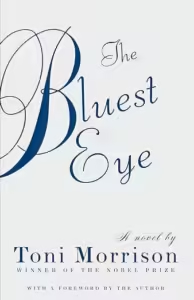The Bluest Eye
Toni Morrison
Vintage
Published June 24, 2007 (Orig. 1970)
Amazon | Bookshop | Goodreads
About The Bluest Eye
Nobel Prize winner Toni Morrison powerfully examines our obsession with beauty and conformity—and asks questions about race, class, and gender with her characteristic subtly and grace.
In Morrison’s bestselling first novel, Pecola Breedlove—an 11-year-old Black girl in an America whose love for its blond, blue-eyed children can devastate all others—prays for her eyes to turn blue: so that she will be beautiful, so that people will look at her, so that her world will be different. This is the story of the nightmare at the heart of her yearning, and the tragedy of its fulfillment.
My Review
Parts of this book were a hard read for me. The writing is moving, fierce, and compassionate. The story explores not only Pecola’s wish to have the blue eyes she believes will make her beautiful but also the lives of the people around her. It follows two sisters, Frieda and Claudia, whose family takes Pecola in when social services remove her from her home. They forge a connection with her that opens and closes the story and offers some reflection on the events that take place.
We also watch what happened to each of Pecola’s parents before they met and after they were married. At one point, Pecola asks for help from a spiritual man who positions himself as having God’s power, and the story illuminates some of his background and past as well. By doing this, Morrison shows not only what happens to Pecola (often from the perspective of a perpetrator) but also why it happens.
It’s a hard read. I loved reading the author’s note at the end of the book in which Toni Morrison reflects on her intentions in telling the story and her evaluation of whether she achieved them. That added some context to the story that I think I needed to hear.
On the whole, I am glad I read this book. The writing is so powerful. I want to read more of Toni Morrison’s work, but already I feel like I see she’s made valuable contributions to literature and our ongoing conversations about race, class, and gender roles.
Discomfort in Literature
One of the things I’ve thought a lot about while reading The Bluest Eye and some of the other books I’ve read lately is the discomfort I experience while reading certain parts of the book. I remember in school really wrestling with stories that left me feeling uncomfortable for various reasons. I wish someone had been able to explain to me the purpose of that discomfort and that discomfort serves an important purpose.
Sometimes, discomfort is a warning sign of danger. It means we need to escape a situation quickly. At other times, though, discomfort is recognition of injustice or wrongdoing. Literature gives us a safe space to experience that discomfort without being in actual physical danger.
This doesn’t mean that reading about trauma can’t be triggering. Sometimes it can. There are certain things I can’t read.
But I’m learning that discomfort isn’t always an indicator that I’m experiencing danger or trauma. Sometimes discomfort means I’m experiencing the injustice or the sense of wrongness in someone else’s story. Sometimes sitting with that discomfort helps us develop empathy or understanding of someone else’s experience.
One of the Most Frequently Challenged Books of 2023
The Bluest Eye was one of the top ten most challenged books of 2023. It has some graphic content, though it’s limited to a few scenes. I definitely think this is a hard book to read, though its messages and perspective are deeply important.
Content Notes for The Bluest Eye
Content warning for graphic sexual assault of a child.
Recommended for Ages 16 up.
Representation
Major characters are Black.
Profanity/Crude Language Content
A few F-bombs and profanity used infrequently. The N-word appears a few times.
Romance/Sexual Content
References to sex and incest. (A girl is pregnant with her father’s baby.) References to nudity. One character befriends and visits three women who are sex workers. More than one scene shows two people having sex. In one, the description is detached and uncomfortable. Others show more pleasure.
In one scene, two white men stumble onto a Black couple having sex. They force the couple to continue while they watch.
One scene shows a man assaulting a child from the man’s perspective. Another passage relates a man’s preference and reasons for preying on girls. He describes some of the things he does.
Spiritual Content
References to prayer and reading the Bible.
Violent Content
References to domestic violence. A man and woman have a violent marriage in which they attack one another. During these episodes, their child wishes she was dead.
Drug Content
A man goes to bed drunk, as is his habit.
Note: This post contains affiliate links, which do not cost you anything to use but help support this blog. All opinions are my own.
